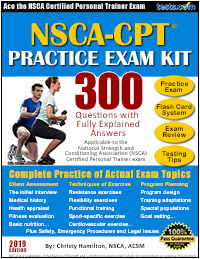NSCA-CPT Practice Exam
Take this free NSCA Certified Personal Trainer practice exam to get an idea of the type of questions that appear on the actual certification exam.
The NSCA Certified Personal Trainer exam is comprised of 155 multiple-choice questions based on four subject areas. These subject areas are as follows:
- Client Consultation and Assessment
- Program Planning
- Techniques of Exercise
- Safety, Emergency Procedures and Legal Issues
For complete practice, check out the NSCA-CPT Practice Exam Kit with 400 questions and fully explained answers. It was written by Amanda Chismar and Christy Hamilton, certified personal trainers and health and fitness writers, holding certifications as NSCA Certified Personal Trainers.
Christy Hamilton
Exam content covers:
Client Consultation/
Assessment:
Initial Interview
Health Appraisal
Medical History Review
Fitness Evaluation
Basic Nutrition
Weight management
Program Planning:
Goal Setting
Program Design
Training Adaptations
Special Populations
Exercise Techniques:
Resistance Machines
Free Weights
Cardiovascular Machines
Non-machine Exercise Techniques
Safety, Emergency Procedures and Legal Issues




